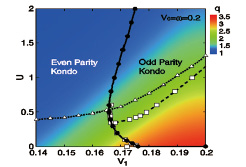Electric Dipolar Kondo Effect Emerging from Vibrating Magnetic Ion
K. Ueda Group
When a magnetic ion vibrates in a metal, it introduces a new channel of hybridization associated with phonon absorption or emission. When an ion is displaced it generally induces electric dipole moment. In such situation, we find that both the magnetic and electric dipole moments are quenched and that the ground state is characterized by spin singlet and parity singlet. In the simplest case of the s-wave localized orbital, the direct hybridization is with s-partial waves and the phonon assisted one with the p-partial waves. In this model, the total parity, which is defined by the number of phonons plus number of electrons in the p-channel by modulo two, is a good quantum number. The parity of the ground state is either even or odd. Just at the boundary between the two ground states with different parities, two-channel Kondo effect is generically observed [1, 2].

Fig. 1. Phase diagram in the parameter space of the phonon assisted hybridization with the p-wave conduction electrons, V1, and the Coulomb interaction, U [3]. In the blue region Kondo effect is characterized primarily by the screening of magnetic moment while in the red region by the screening of electric dipole moment. The ground state is spin-siglet and parity singlet with different parities, even on the left hand side but odd on the right hand side. At the boundary, two-channel Kondo effect takes place generically.
We find that the best quantity to discuss nature of the non-magnetic Kondo effect which is realized in the weak correlation regime is the susceptibility of the electric dipole moment [3]. When the electron phonon coupling is strong and at the same time the Coulomb interaction is weak, the electric dipolar susceptibility shows a Curie law in a certain temperature range, which is a clear indication of the formation of electric dipole moment, doubly degenerate states with right polarization and left one. Below the Kondo temperature of the electric dipolar Kondo effect, the electric dipole moment starts to be quenched through the phonon assisted hybridization processes.
In the regime of the electric dipolar Kondo effect, electronic specific heat at low temperatures is generally enhanced. However, the enhancement factor is insensitive to magnetic field, except for the close vicinity of the line of two-channel Kondo fixed points.
References
- [1] S. Yashiki, S. Kirino, and K. Ueda, J. Phys. Soc. Jpn. 79, 093707 (2010).
- [2] S. Yashiki, S. Kirino, K. Hattori, and K. Ueda, J. Phys. Soc. Jpn. 80, 064702 (2011).
- [3] T. Hotta and K. Ueda, arXiv:cond-mat/1203.4692, Phys. Rev. Lett. (to be published).
